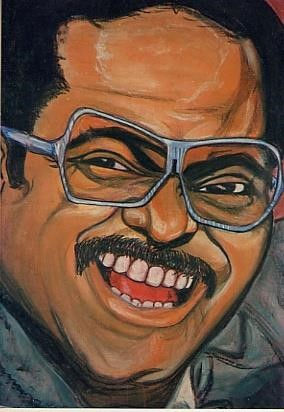

1960
Eric Kelly III began drawing at the age of four, using pencil and crayon to interpret the world around him. His early affinity for bold lines and vivid colors was more than childhood curiosity—it was the beginning of a lifelong journey in art, sound, and emotion. Eric lives with synesthesia, a rare sensory condition that allows him to see colors and shapes when he hears music. This fusion of senses would shape his entire artistic career, allowing him to transform the audible into the visual.

1965 - 1971
1965–1971 – Figuration and Early Identity
As a young prodigy, Eric’s early work revolved around figurative drawing and portraiture, often sketching family, community members, and influential Black leaders. Even at this stage, his drawings were more than likenesses—they conveyed emotion and spirit. Listening to jazz and gospel as a child, Eric saw bursts of color with each note, which translated into his unique shading and line work. His early work laid the foundation for what would become a vibrant, expressive style.
1972 - 1983
1972–1977 – Realism and Academic Exploration
Entering adolescence, Eric honed his skills in super-realism. Working with graphite and pastels, he created detailed, photographic representations of urban life and Black culture. Influenced by the civil rights movement and photojournalism, Eric’s work captured the resilience and struggle of his generation. During this period, his synesthetic abilities deepened—he began associating certain instruments and vocal tones with visual textures, which became embedded in the details of his expressive drawings.

1978 - 1983
1978–1983 – Expressive Art and Emotional Color
In his late teens and early twenties, Eric transitioned from realism to expressive art. Free from the constraints of photographic precision, he allowed bold strokes and vibrant colors to lead the way. Music became his muse; jazz solos turned into sweeping reds, blues, and golds. This era saw Eric pour emotion onto the canvas, guided by rhythm and soul. The connection between music, memory, and movement became his palette.

1984 - 1989
1984–1989 – Abstract Expressionism
Embracing the freedom of abstract expressionism, Eric’s work exploded with energy and intention. His canvases became emotional landscapes—large-scale, layered, and loud. Using textured brushwork, dripping paint, and calligraphic linework, he allowed improvisational jazz and soul music to dictate color choices and composition. His art embodied a storm of liberation and inner awakening, reflecting both the chaos and harmony he felt while listening to sound.

1990 - 1995
1990–1995 – Pure Abstraction
Eric evolved into pure idenity, moving into representation altogether. He began working with mixed media—sculpture, pastels, acrylics—to bring dimension to the sensations he experienced through music. Each composition was a dialogue between shape, color, and frequency. This period marked a deep spiritual and metaphysical exploration, where art became sprit, and color became language.

1996 - 2001
1996–2001 – Cubism & Structured Interpretation
Influenced by African tribal art and modernist masters, Eric adopted triamgle, squares and circles as a new language. He deconstructed form into geometric patterns, representing different sound structures—basslines became vertical blocks, percussion rhythms appeared as angular shards. Through cubism, he explored how fragmented experiences, like sound and memory, could come together as a whole narrative on canvas.

2002- 2007
2002–2007 – Fusion & Symbolic Abstraction
This era saw Eric synthesizing all previous styles into one cohesive voice. Figurative sketches floated within abstract shapes. Tribal symbolism met color theory. Sacred geometry and spiritual iconography emerged through layered compositions. Music continued to drive his process, as every stroke was inspired by frequencies that moved him—turning rhythm into ritual and shape into spirit.

2008 - 2013
2008–2013 – Digital Integration
Eric embraced digital technology, blending tradition with innovation. He created digital collages, projection mapping pieces, and video art installations. His work was now not only visible but also immersive—allowing viewers to step inside his world of sound and sight. These explorations brought his synesthetic experience to life in new and groundbreaking ways.

2014 - 2019
2014–2019 – Multi-Media Mastery
Eric pushed boundaries by combining physical, digital, and performance art. He created multi-sensory installations with layered soundscapes, sculptures, and live painting. His exhibitions became experiences, engaging the eyes, ears, and heart. Art and audience became collaborators in an evolving dance of perception and participation.
2020 - 2025
2020–2025 –AFRO TEARS
NFT & Global Art Innovation
Entering the digital frontier, Eric released a series of NFT artworks—each one a digital translation of music into motion and color. These works captured not only his lifetime of aesthetic mastery but also his lifelong gift of seeing sound. Globally collected and celebrated, his NFTs introduced new audiences to the vibrant intersection of identity, technology, and creativity.
Eric’s upcoming film, Human Landscapes, will take this journey to screen. It explores the intersection of life, art, and identity through the lens of his synesthesia and abstract expressionism. Premiering this fall, the film immerses audiences in the emotional geometry of music and memory, offering an unforgettable experience of color, light, and feeling.
“Art can serve as a powerful catalyst for improving the world,” says Kelly. “By using color, bold lines, and texture, I aim to inspire positive change and create a sense of harmony.”
Through every era and medium, Eric Kelly III has proven that art is not only seen, but also heard, felt, and lived.








